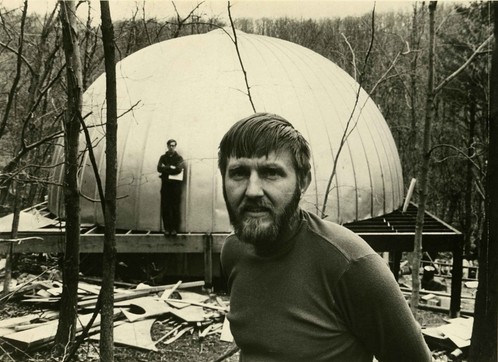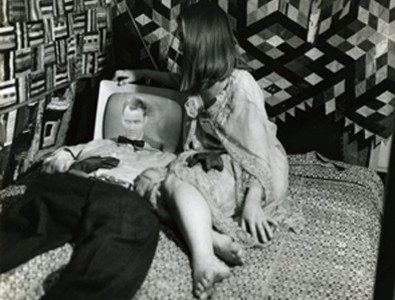Stan VanDerBeek Exhibition at MIT
List Visual Arts Center Feb. 4 to April 3
By: List - Dec 22, 2010
The MIT List Visual Arts Center and the Contemporary Arts Museum, Houston present the first museum survey of the work of media art pioneer Stan VanDerBeek (1927-1984). Surveying the artist's remarkable body of work in collage, experimental film, performance, participatory, and computer-generated art over several decades, Stan VanDerBeek: The Culture Intercom highlights the artist's pivotal contributions to today's media-based artistic practices. The exhibition features dozens of early paintings and collages, an exhaustive selection of his pioneering animations and films, re-creations of immersive projection and "expanded cinema" environments, documentation of site-specific and telecommunications projects, and material related to his performance and durational work.
Describing himself as a "technological fruit picker," VanDerBeek consistently turned to new technological means to expand the social and emotive potential of emergent technology and media. Emerging from the progressivist and intermedia tradition of Black Mountain College, VanDerBeek created technologically hybrid and participatory artworks through the 1960s and '70s. His early drawings and collages, heavily influenced by Dada and the expressionism of the Beat Generation, already hinted at the artist's interest in the transformation of perception and knowledge in an electronic age and the relationship between art, technology, and the human condition.
VanDerBeek's animations and short films, beginning in the late 1950s, made him a central figure in American underground film. Combining stop-motion animation drawn from collages of magazine illustrations and advertisementsn with filmed sequences and found footage, films such as Achoo Mr. Kerroochev (1960) and Breathdeath (1963) fused avant-garde cinematic techniques with social critique and Cold War politics.
VanDerBeek's interest shifted to "expanded cinema" and immersive and multimedia work in the mid-1960s. His Movie-Drome (1963-1965), an audiovisual laboratory and theater built in Stony Point, New York, was conceived as an environment to present multiple film projections. These so-called "movie-murals" or "newsreels of dreams" were part of the artist's research into developing new visual languages that could be used as tools for world communication. VanDerBeek articulated these concerns that were centered on the social potential of media through a series of influential texts, expressing his critical assessment of the social and utopian character of technology and the responsibility of the artist in shaping its future.
Always at the forefront of new information, communication, and visualization technologies, VanDerBeek readily embraced computer graphics, image-processing systems, and various new technological forms through the late 1960s and early '70s. At Bell Labs, working with the first moving-image programming language, he produced Poemfields (1966-1969), a series of computer-generated films. As a research fellow at MIT's Center for Advanced Visual Studies (CAVS) and artist-in-residence at Boston's public television station WGBH, he began to develop new forms of interdisciplinary work and integrated forms of visual information that now stand as significant experiments in early new media art. For Telephone Mural (1970), developed and conceived at CAVS in 1969, VanDerBeek experimented with transmitting art over telephone using a Xerox machine called a "Telecopier." A mosaic-like mural of images would be composed in "real time," sent from his studio at MIT to any location in the world that had access to a telephone line and a similar machine, and then reordered on site.
Working with WGBH television, VanDerBeek produced Violence Sonata (1970), a mix of live studio television transmission and prerecorded video work that questioned violence and race relations in America. VanDerBeek went on to conceive several complex cinematic and performance events at planetariums and museums before his untimely death in 1984.
Beginning with a selection of early abstract paintings, watercolors, and photographs the exhibition features a rotating three-hour program of more than a dozen of VanDerBeek's renowned animations, along with over forty of the existing collages from his films. The artist's series of computer-generated films, Poemfields (1966-1969), exploring early computer graphics and image-processing systems, are included as four multiple screen projections, along with Variations V (1966), VanDerBeek's multi-media collaboration with Merce Cunningham, John Cage, David Tudor, and Nam June Paik. The exhibition also re-creates two of VanDerBeek's significant works: Movie Mural (1968), a multimedia installation comprised of several slide and video projections, and a version of the large fax murals created at MIT's Center for Advanced Visual Studies and the Walker Art Center in the early 1970s. Immersive, participatory, and media-based projects such as Violence Sonata (1970) and Cine-Dreams (1972) will be featured through rare footage, original drawings and texts, and extensive documentation.
Stan VanDerBeek: The Culture Intercom is organized by Bill Arning, Director of the Contemporary Arts Museum, Houston; London-based curator Mark Bartlett; and João Ribas, Curator, MIT List Visual Arts Center.
A fully illustrated catalogue accompanies the exhibition. Through scholarly research on several facets of VanDerBeek's art practice, including the concept of "expanded cinema" and his contributions to media theory, the catalogue highlights the fusing of technology, film, performance, and multimedia that define VanDerBeek's place in the aesthetics of media art. Along with essays by the exhibition's three curators, the publication includes essays by Jacob Proctor, Associate Curator of Modern and Contemporary Art, University of Michigan Museum of Art, Ann Arbor, MI; Gloria Sutton, Roski School of Fine Arts, University of Southern California, Los Angeles, CA; and Michael Zyrd, York University, Toronto, Ontario, Canada.
About the Artist
Stan VanDerBeek was born in New York, NY, 1927 and died in Baltimore, MD, in 1984. VanDerBeek studied at Cooper Union and Black Mountain College, receiving honorary doctorate degrees from Black Mountain College (1957) and Cooper Union, New York (1972). The artist's film work has been presented in numerous film festivals since 1967, including the Lincoln Center Film Festival, the London Film Festival, the Washington International Film Festival, and the New York International Film Festival. He was the recipient of many grant awards including several from the National Endowment from the Arts, the Rockefeller Foundation, the Ford Foundation, The Guggenheim Foundation, and an American Film Institute Independent Filmmaker award. VanDerBeek collaborated with numerous organizations serving as a residency artist and researcher. These included television stations, universities, foundations, scientific laboratories, and government agencies among them: Bell Labs, CBS-TV, Boston's public television station WGBH, MIT's Center for Advanced Visual Studies, National Aeronautics Space Administration (NASA), and the United States Information Agency (USIA). VanDerBeek taught at Columbia University (1963-65), State University of New York (SUNY) Stony Brook (1967-72), and University of South Florida (1972-75). From 1975 until his death in 1984, he was a Professor of Art at the University of Maryland, Baltimore, MD.
VanDerBeek's work was included in the pioneering exhibitions Cybernetic Serendipity, Institute of Contemporary Art, (ICA) London, U.K., Smithsonian Institute, Washington, DC (1968-69); The Projected Image, Institute of Contemporary Art, Boston, MA (1968); and Software, The Jewish Museum, New York, NY (1970). His work was also included in the 1983 Whitney Biennial exhibition, Whitney Museum of American Art, New York, NY. In addition, VanDerBeek's work has been shown at the Stedelijk Museum, Amsterdam, Netherlands; Walker Art Center, Minneapolis, MN; Kunsthaus Zürich, Zürich, Switzerland; Anthology Film Archives, New York, NY; Museum Moderner Kunst Stiftung Ludwig, Vienna Austria; the Seattle Art Museum, Seattle, WA; and the Museum of Modern Art, NY, among many others. His work can also be found in the collections of the Museum of Modern Art, NY; the Centre Pompidou, Paris, France; The Art
Institute of Chicago, Chicago, IL; The Pennsylvania State University, State College, PA; and The Arts Council of Great Britain, London, UK.
Stan VanDerBeek: The Culture Intercom has been organized by the MIT List Visual Arts Center and the Contemporary Arts Museum Houston. The exhibition has been made possible by the generous support of Art Mentor Foundation Lucerne and The National Endowment for the Arts, a Federal agency, along with the Council for the Arts at MIT, the Massachusetts Cultural Council, Martin E. Zimmerman, the Union Pacific Foundation, the patrons, benefactors, and donors to the Contemporary Arts Museum Houston's Major Exhibition Fund. The accompanying catalogue has been made possible by a grant from The Brown Foundation, Inc. Media sponsor: Phoenix Media/Communications Group.




